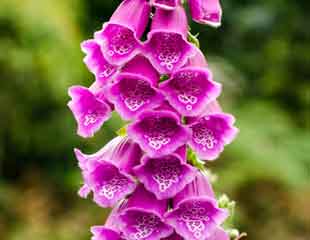
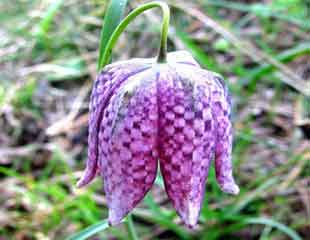
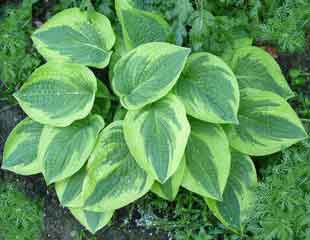
Plants for Damp Shade
There are many plants and shrubs which will survive and growing happily in damp shade. These plants will tolerate partial shade conditions, and ground conditions which are damp, as opposed to plants suitable for dry shade.
There are three examples illustrated above. Left is Digitalis purpurea, Foxglove, of which there are several varieties, including a pure white variety 'Alba'. Digitalis will grow in the sun or shade and will grow where it is damp, and also in dry areas such as walls. Foxgloves are a very forgiving plant. They are biennials which flower in the summer and self seed around the garden to produce new flowers year after year. Digitalis are easy to grow, but one cautionary note is that all parts of Digitalis are poisonous.
Illustrated above right is Hosta, well known for being tolerant of damp and shady conditions, some varieties more so than others. Ideal Hostas for damp shade are H. fortunei 'Albomarginata' large Hosta 75cms with green and white ivory variegated leaves; H fortunei albopicta large 75 cms variegated hosta ; H.'Frances Williams'(sieboldiana) smaller 60cms blue green leaves; H. 'Halcyon' smaller Hosta at 30cms blue leaves. Hostas are easy to grow (apart from the problem with slugs and snails and tips on how to beat them;) and there are many many varieties to choose from of all sizes and variegations, with more tips and images on the growing Hostas pages.
Illustrated centre is Fritillaria meleagris, the delicate Snake's Head Fritillary, a spring flowering bulb happy to grow in shade and quite wet soils, see below.
The list below includes many plants that are easy to grow and have a green wheelbarrow label, while more difficult plants have an amber wheelbarrow label indicating medium difficulty to grow.
All the plants listed and more are available for sale on crocus website.

Easy to grow plants for damp shade
Best Plants for Damp Shade
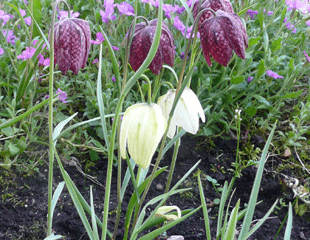
Fritillaria meleagris
Fritillaria meleagris, common name Snake's Head Fritillary, is a lovely delicate bulb which flowers in spring and has chequered bell-like flowers in shades of purple and F. Alba is a white variety. Both are fully hardy. Good in damp soil and also tolerant in some shade. Easy to grow, and once established, Fritillaria meleagris will multiply and populate a suitable damp area of the garden and come up reliably each year. They are low growing up to 25/30cms. They are ideal naturalised in a wild/meadow setting.
Persicaria
Persicaria has a preference for damp soil and will tolerate partial shade. The most commonly grown are P.affinis, P bistorta, P. milletti and all have flower heads which are spikes and shades of pink, and red. They tend to be long flowering. In ideal conditions Persicaria can be slightly invasive towards plants around but an ideal, clump forming, maintenance free perennial plant.
Persicaria amplexicaulis Red Bistort, is a bee magnet which is less common for such a shade loving plant. The short video hums with bees and pollinators.
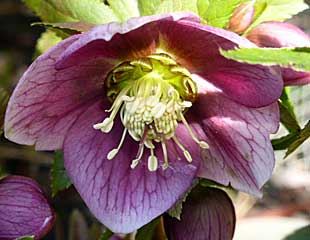
Hellebores
Several Hellebores are suitable for damp shade and grouped together they make a lovely late winter and early spring display. Helleborus orientalis 'The lenten Rose' is particularly attractive as is the H. Niger 'The Christmas Carol', both are tolerant of shade and damp soil. Hellebores make a neat clump and are trouble free apart from black spot.
They look good in a woodland setting such as under planting Rhododendrons, some of which will grow in shade. Hellebores are easy to grow plants which spread and self seed in a well-behaved way; tips and advice on growing Hellebores. They are also suitable for growing in containers for winter bedding scheme.
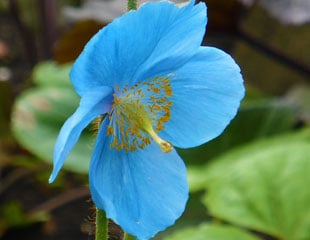
Meconopsis Himalayan Blue Poppy
Meconopsis is a stunning poppy with beautiful blue blooms. However, the Himalayan Blue Poppy's difficulty in cultivation is attributed to its specific needs: cool, damp, shady areas. It thrives best in northern areas of the UK and is unsuited to drier sunny areas. It is a summer flowering poppy, from May to July, and does best in a woodland setting. It is also short lived, M. Lingholm is a perennial version which will last a few seasons. It can be propagated by division.
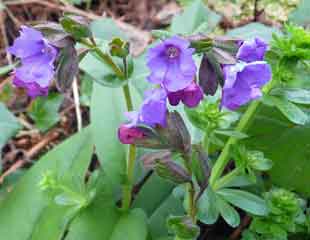
Pulmonaria
Pulmonarias, common name lungwort, are a small perennial tolerant of damp shade. They are low growing, late winter flowering and form excellent ground cover. Because they flower early in the year, Pulmonaria is a source of nectar for emerging solitary bees in late winter. Pulmonarias are easy to grow and form neat clumps if left undisturbed.
Their flowering colours are blue, pink or white, and some varieties have mottled, variegated leave. Pulmonaria is ideal planted alongside early flowering spring bulbs and primula. Depending on where in the country they are being grown, Pulmonarias flower from around late January onwards.
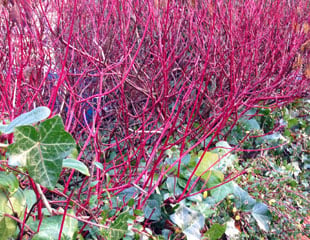
Cornus
Cornus, common name 'dogwood', is a deciduous shrub which has winter colour provided by their striking coloured stems, as illustrated left the variety Cornus Alba. For good winter colour, there is also 'Elegantissima' and 'Sibirica' and Cornus sericea 'Flaviramea' for yellow stems. Growing them in full sun will result in the best stem colour, but they can also tolerate partial shade. However, Cornus does not thrive in dense shade.
Cornus has a variegated leaf and creamy white flowers in late spring and summer. To maintain stems colour, Cornus are best coppiced cut to the ground in late winter. Here is a step-by-step video showing how to coppice Cornus.
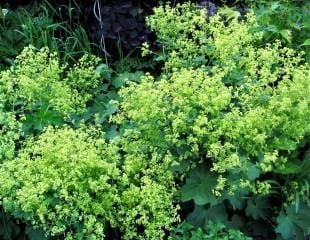
Alchemilla mollis
Alchemilla mollis will grow in partial shade and damp conditions. Alchemilla is a herbaceous perennial and very easy to grow, too easy. It carries a garden warning because it is a vigorous self seeder, and will pop up everywhere once established. Alchemilla is easy to remove or thin out, and it can be very effective in situations where ground cover is needed. It looks good growing with Primula, many varieties of which are also tolerant of these conditions. Alchemilla can look a bit ragged and tired later in the growing season when it is best cut back right to the ground and it will rapidly replace with fresh green foliage for the rest of the season.
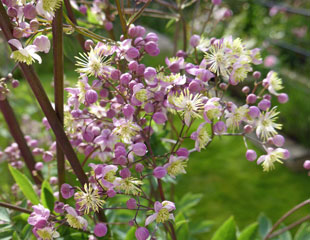
Thalictrum
One of my absolute favourite plants, which is so colourful and graceful, is Thalictrum. It is a tall, herbaceous perennial which returns reliably every year. You can get a white variety, T. 'Alba' but more common and widely available are the purple varieties, which produce tiny fluffy purple flowers and tall stems which sway around in the breeze. Unless planted in an exposed area, Thalictrum can grow without the need for staking, despite its tall height. There is so much to recommend Thalictrum, reliable, easy to grow with lovely flowers leaving attractive seed heads. For tips about growing Thalictrum.

Astilbe
Astilbe is a great plant for damp conditions and tolerant of partial shade. Astilbes come in many colours, mainly pinks, purples, white and cream. The Astilbe illustrated, Astilbe 'Professor van der Wielen' is a bright white variety and, like all Astilbes, easy to grow. Astilbe will flower reliably for many years, making them good value for money. Astilbes look good with ferns, many of which are also tolerant of shady, damp conditions. The flower heads are soft and fluffy and a good mix in the border. An easy to grow reliable plant which needs no maintenance. The national collection can enjoyed at the lovely Lakeland garden of Holehird.
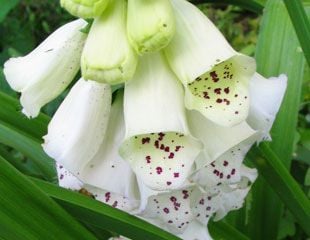
The Foxglove is tolerant of many growing conditions, including damp shady sites. Often thought of as a cottage style plant, the white varieties look very stylish, especially in shade areas of the garden where they look illuminating.
Foxgloves are easy to grow, self seeding biennial but note all parts are poisonous.
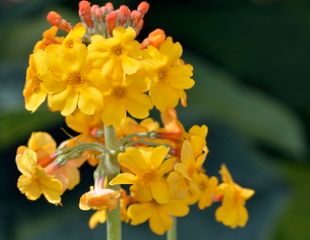
Primula makes a colourful display and many varieties will tolerate damp shade. Illustrated is a variety Candelabra primula, and particularly popular is a variety called P. candelabra Harlow Carr where it is grown on mass, and to great effect, in a damp area streamside at the RHS garden.
There are many varieties to choose from, more growing information.
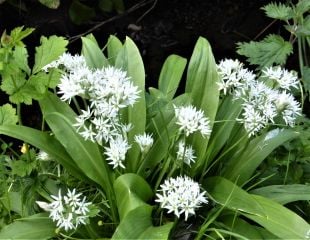
Wild Garlic, Allium ursinum is suitable to grow in damp shady areas. It is a low-growing perennial with white flowers. The plant exudes a strong garlic smell in spring when in flower. The leaves and flowers have a garlic taste and can be eaten. Wild garlic looks good in an informal or wild setting.
It is important only to eat a plant if you are 100% confident of your plant identification. The majority of garden plants, excluding cultivated vegetables, have a degree of toxicity.
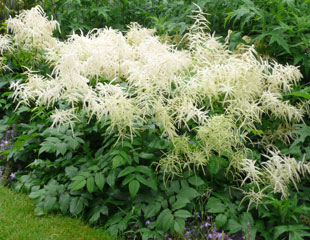
A little similar to Astilbe, this is Aruncus-dioicus-'Kneiffii' which is also a deciduous herbaceous perennial but bigger than Astilbe as mature plants will reach up to 2m. Both leaves and flowers are larger than Astilbe and it only flowers in a creamy white colour. It is a tough plant, fully hardy to H6. It will grow in virtually all conditions and is ideally suited to damp acid soil in partial shade.
I have seen it in a number of gardens planted streamside with Hosta and Persicaria, an ideal damp shade combination.
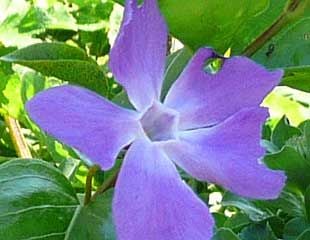
Vinca common name periwinkle, will tolerate most conditions including shade and damp.It flowers in blue, violet and white. It is an evergreen perennial. I have seen it planted to good effect tumbling down a shady bank, as ground cover under shrubs and trees, scrambling up through an evergreen hedge.
It is a tough plant and can be considered invasive, for which reason I recommended planting Vinca minor, ( several varieties are available from Crocus) rather than V. major, which is the more invasive variety.

A fantastic shade plant Hosta is easy to grow with the caveat of slug protection. Hosta is a herbaceous perennial. It returns reliably each year and is grown for its very attractive foliage.
There are many varieties of Hosta to choose from giants to tiny petite plants. Many Hosta have very attractive variegated leaves but although easy to grow, they are slug and snail magnets, (advice on how to beat the slugs.) Grow the more slug resistant varieties.
Persicaria
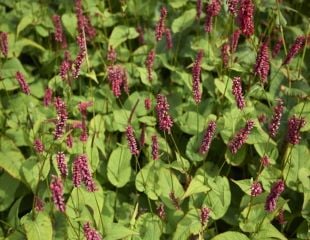
Persicaria amplexicaulis is best grown in damp, moisture retentive soil in semishade. It is suitable for bog gardens, pond margins and damp areas and is also very attractive to bees as the short video shows. Many bee friendly plants are sun lovers, Persicaria amplexicaulis is a welcome exception .

Medium difficulty

Meconopsis
Meconopsis Grandis 'Branklyn' the Himalayan Blue Poppy is a stunning plant, but it is not easy to grow and can be short-lived. Meconopsis will only grow in a sheltered spot in moist, acid soil. It will not tolerate warm dry spots. It is a native of Tibet where summers are cool and wet and winters cold and snowy. Meconopis will grow to around 1m, it is summer flowering and fully hardy. If Meconopis is grown in a dry spot it will be Monocarpic, i.e. die after flowering, so the right spot is crucial. Some varieties are Monocarpic by nature, which makes selecting a variety is important.
Suggested varieties to try are M. betonicifolia and grandis, which are not by nature monocarpic and have the additional benefit of having the RHS garden merit award, making them a good choice. The Himalayan Blue Poppy is a plant which thrives best in the norther parts of British Isle and Scotland to enjoy conditions which are cooler and wetter. Recommended varieties with award of garden merit are M.baileyi, M 'Slieve Donard' (available from Crocus) M 'Jimmy Bane', M. 'Huntfield' and M. 'Barney's Blue'.
